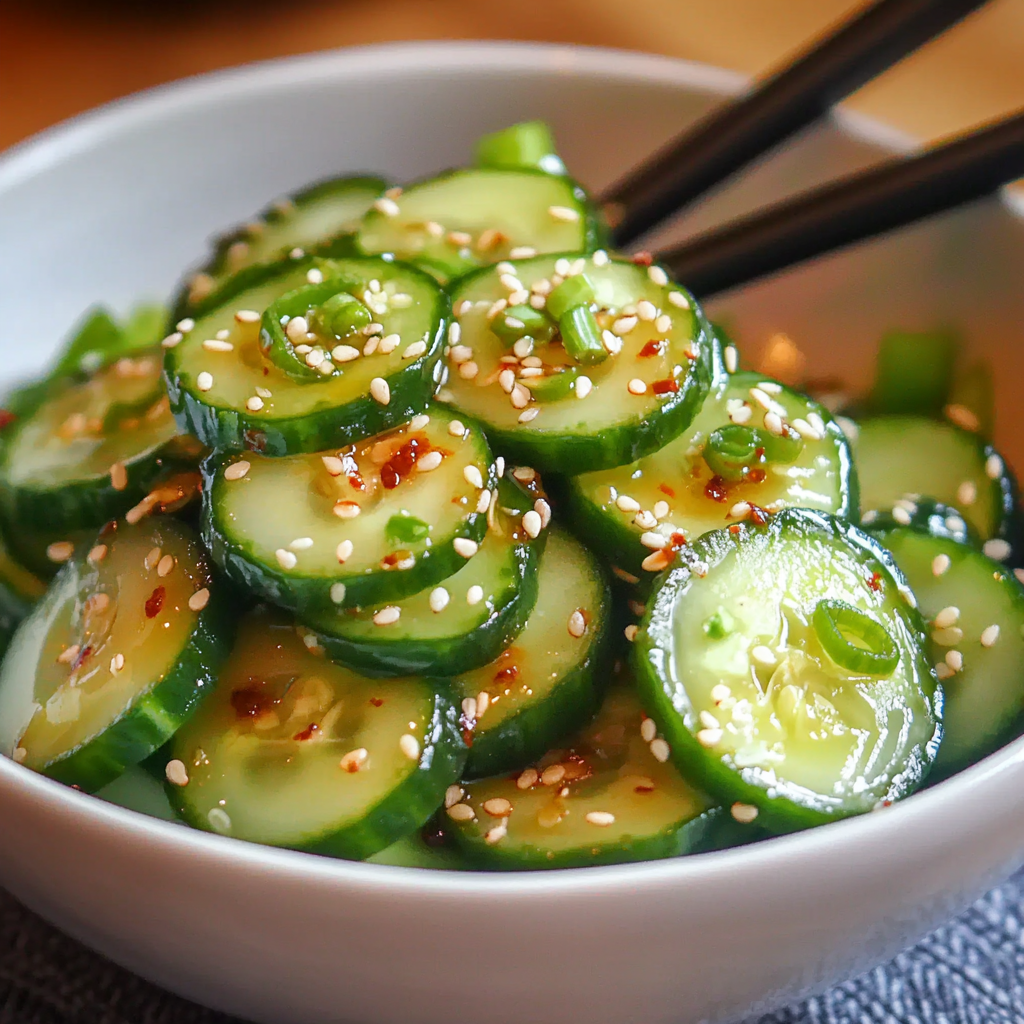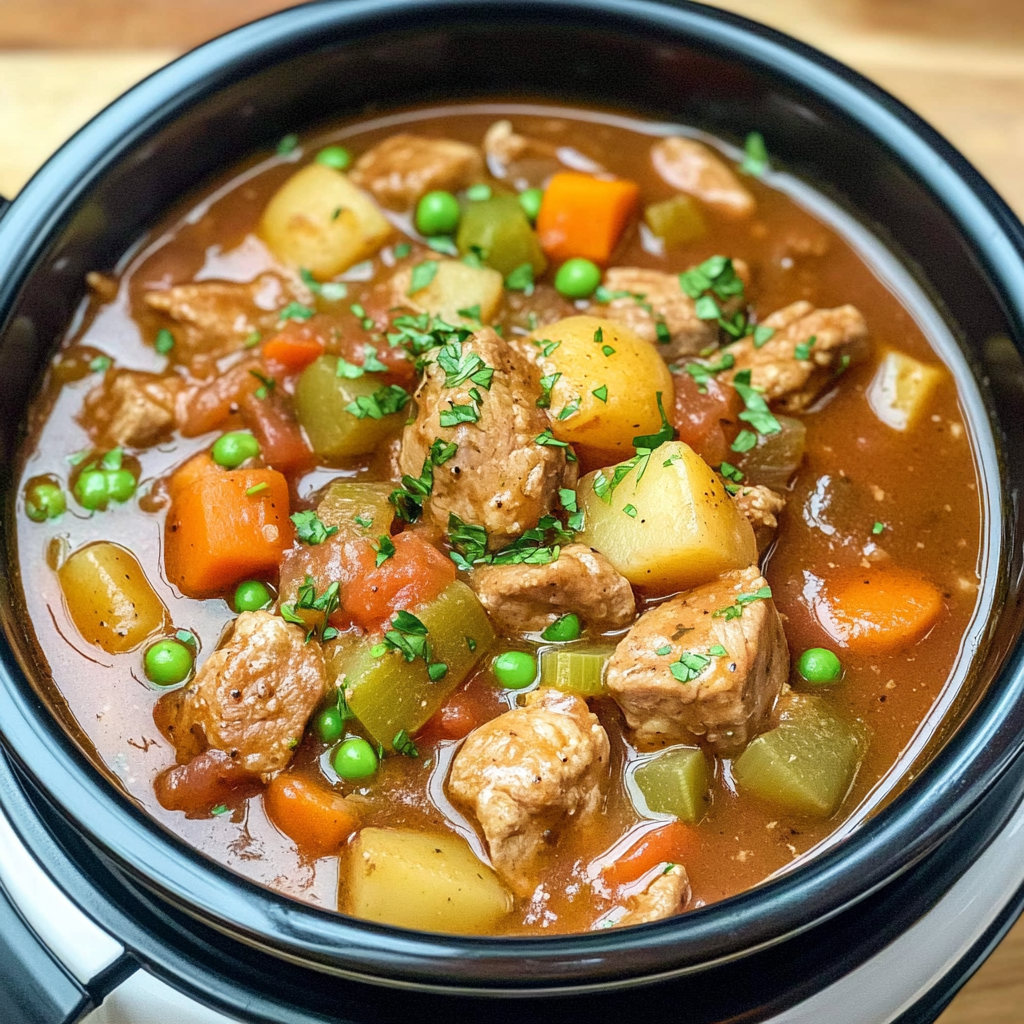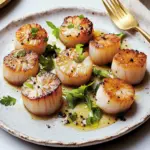Crisp, cool cucumbers dressed in a spicy, tangy marinade – this Korean cucumber salad, also known as Oi Muchim, is a flavor-packed side dish that comes together in just 15 minutes. With garlic, sesame oil, gochugaru, and soy, it delivers that perfect balance of heat, acidity, and umami.
Whether you’re serving Korean BBQ, bibimbap, or a simple rice bowl, this salad adds just the right amount of crunch and flavor to any plate. It’s also completely plant-based and easy to prepare ahead of time, making it a go-to side for both casual meals and festive feasts.
Full Recipe
Ingredients:
-
2 large cucumbers (preferably Korean or Persian), thinly sliced
-
1 ½ teaspoons salt
-
1 tablespoon rice vinegar
-
1 tablespoon soy sauce
-
1 tablespoon sesame oil
-
2 teaspoons sugar
-
1 tablespoon gochugaru (Korean red pepper flakes)
-
2 cloves garlic, minced
-
1 green onion, chopped
-
1 teaspoon toasted sesame seeds
Directions:
-
Slice the cucumbers thinly and place them in a bowl. Sprinkle with salt, toss gently, and let sit for 10 minutes. This draws out excess water.
-
After 10 minutes, drain the cucumbers and gently squeeze out any remaining moisture.
-
In a separate bowl, combine rice vinegar, soy sauce, sesame oil, sugar, gochugaru, and garlic. Mix well until sugar is dissolved.
-
Add the cucumbers to the sauce mixture and toss until evenly coated.
-
Sprinkle with green onions and sesame seeds before serving.
-
Chill in the fridge for 10-15 minutes before serving for best flavor.
Prep Time: 15 minutes | Cooking Time: 0 minutes | Total Time: 15 minutes
Kcal: 65 kcal | Servings: 4 servings
Introduction to Korean Cucumber Salad (Oi Muchim)
Korean cuisine is known for its vibrant flavors, fermented elements, and colorful side dishes known as banchan. Among these, Oi Muchim — a spicy Korean cucumber salad — stands out for its refreshing crunch and spicy-sour punch. This dish is a staple on Korean tables, accompanying everything from grilled meats to stews and rice bowls. It’s a quick, no-cook side dish that’s as nutritious as it is delicious.
Unlike Western cucumber salads that might lean toward creamy or vinegary profiles, Oi Muchim delivers a bold taste with a signature Korean twist: gochugaru (Korean red pepper flakes), sesame oil, garlic, and rice vinegar. The result is a light yet flavor-forward dish that balances heat, acidity, sweetness, and umami all in one bite.
Cultural Significance and Origins
Oi Muchim is deeply rooted in Korean culinary tradition. The word “Oi” means cucumber in Korean, and “Muchim” translates to “seasoned” or “mixed.” This dish is a part of banchan, the collective name for the assortment of side dishes served with every Korean meal. Banchan isn’t just a complement to a main course — it’s a vital part of the Korean dining experience, promoting shared meals and a balance of textures and flavors.
Cucumber salad is especially popular during the warmer months because of its cooling and hydrating properties. It’s often made fresh just before serving, which keeps the cucumbers crisp and the flavors vibrant.
Why This Dish is So Popular
One of the most appealing aspects of Korean cucumber salad is its simplicity. With a short list of ingredients and minimal preparation, this dish packs a flavor punch in a matter of minutes. It’s perfect for weeknight dinners, barbecues, or as a bright contrast to heavier dishes like Korean short ribs (galbi) or spicy tofu stew (soondubu jjigae).
Its popularity also stems from its versatility. It can be made more or less spicy, sweeter or tangier, depending on personal taste. It’s also naturally vegan and gluten-free (if you use gluten-free soy sauce), making it ideal for a wide range of dietary needs.
The Key Flavor Elements
What sets this salad apart is its balance of traditional Korean seasoning components. Gochugaru brings a deep, smoky heat; garlic adds a sharp pungency; rice vinegar contributes a clean acidity; and sesame oil provides rich nuttiness. These ingredients blend into a dressing that penetrates the cucumbers while preserving their satisfying crunch.
Toasted sesame seeds and chopped scallions round out the dish, adding both texture and color. While each ingredient on its own may seem straightforward, their combination creates a complex and addictive flavor profile.
Tips for Perfect Korean Cucumber Salad
-
Use the right cucumbers: Korean or Persian cucumbers are ideal due to their thin skins and minimal seeds. English cucumbers can work as well, but avoid waxy-skinned varieties like standard American slicing cucumbers, which can be bitter and watery.
-
Salt the cucumbers first: Salting the cucumbers and letting them sit for about 10 minutes draws out excess water, improving texture and preventing the salad from becoming soggy.
-
Adjust the seasoning: This salad is highly customizable. Like it hotter? Add more gochugaru. Prefer a sweeter profile? Increase the sugar slightly. You can also add soy sauce for umami depth or substitute with tamari for a gluten-free option.
-
Serve fresh: While the salad can sit in the fridge for a few hours, it’s best enjoyed shortly after preparation to preserve the cucumbers’ crunch and the freshness of the flavors.
Serving Suggestions
Oi Muchim is incredibly flexible when it comes to serving. Here are a few ideas:
-
As a side dish with Korean BBQ: The spicy and tangy flavors cut through the richness of grilled meats like bulgogi or samgyeopsal (pork belly).
-
Paired with rice dishes: A scoop of Oi Muchim next to steamed rice and a fried egg creates a simple but flavorful meal.
-
In a wrap or taco: Use it as a topping for Korean fusion dishes like beef bulgogi tacos or lettuce wraps.
-
With noodles: Add it to cold soba or Korean glass noodles for a bright, refreshing element.
This salad also works well in a picnic or potluck spread. It’s light, doesn’t need to be reheated, and travels well if stored in an airtight container.
Health Benefits
Cucumbers are hydrating and low in calories, making them excellent for digestion and weight management. They contain antioxidants like beta carotene and flavonoids, which may help reduce inflammation. The addition of garlic offers antimicrobial properties, while sesame seeds provide heart-healthy fats and minerals.
Because this dish uses no added preservatives, dairy, or gluten, it’s an excellent choice for people following clean, plant-based, or allergen-aware diets. Plus, its bold taste helps curb cravings for heavier or overly processed foods.
Common Variations
Korean cucumber salad is easy to tweak based on what’s available or preferred:
-
Add thinly sliced onions or carrots for an extra layer of crunch and sweetness.
-
Include a splash of fish sauce for a salty, umami boost (though this makes it non-vegan).
-
Try adding a pinch of sugar and some apple cider vinegar instead of rice vinegar for a slightly different acidic note.
-
Top with crushed roasted peanuts for a Thai-inspired fusion twist.
-
Mix in fresh chili slices for an even bolder spicy kick.
These changes allow you to reinvent the dish while keeping the spirit of Oi Muchim alive.
Storage and Shelf Life
Since cucumbers naturally release moisture over time, this salad is best enjoyed within a day. However, if stored in the refrigerator in an airtight container, it can last up to 2 days. Beyond that, the texture may soften, and the flavors can become diluted.
To freshen it up the next day, consider draining any excess liquid and tossing the salad again with a touch of vinegar or fresh gochugaru before serving.
Conclusion
Korean cucumber salad (Oi Muchim) is a shining example of how simple ingredients, when thoughtfully combined, can create something extraordinary. It’s a dish that satisfies multiple senses: crisp in texture, bright in color, bold in flavor. It’s perfect as a quick side, a palate cleanser, or even a small meal on its own.
Whether you’re new to Korean cuisine or a seasoned home cook, adding this spicy cucumber salad to your rotation is a decision your taste buds will thank you for. It’s light, customizable, and easy to prepare — proof that a great dish doesn’t have to be complicated. Enjoy it with your favorite Korean meals or mix it into your weekly menu for a refreshing twist.








